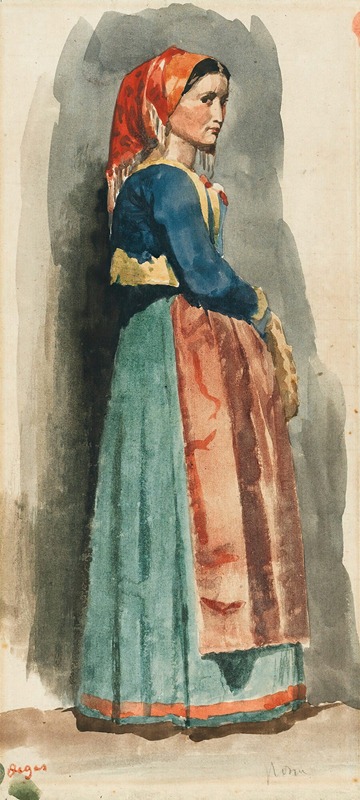
Italienne
A hand-painted replica of Edgar Degas’s masterpiece Italienne, meticulously crafted by professional artists to capture the true essence of the original. Each piece is created with museum-quality canvas and rare mineral pigments, carefully painted by experienced artists with delicate brushstrokes and rich, layered colors to perfectly recreate the texture of the original artwork. Unlike machine-printed reproductions, this hand-painted version brings the painting to life, infused with the artist’s emotions and skill in every stroke. Whether for personal collection or home decoration, it instantly elevates the artistic atmosphere of any space.
Edgar Degas, a prominent French artist associated with the Impressionist movement, created a painting titled Italienne (The Italian Woman). This artwork is believed to have been completed in the mid-19th century, during Degas's early career when he was exploring portraiture and experimenting with different styles and techniques. Unlike his later works that often focused on dancers, bathers, and scenes of modern life, Italienne reflects Degas's interest in traditional portraiture and his study of the Old Masters.
The painting depicts a young Italian woman, characterized by her contemplative expression and traditional attire. Degas's use of muted tones and careful attention to detail in the subject's features and clothing demonstrate his academic training and influence from classical art. During this period, Degas was deeply inspired by his travels to Italy, where he studied Renaissance art and absorbed the techniques of artists such as Raphael and Titian. This influence is evident in Italienne, particularly in the composition and the emphasis on the subject's individuality.
Italienne is notable for its restrained color palette and the subtle interplay of light and shadow, which highlight the sitter's face and create a sense of depth. The painting showcases Degas's skill in capturing the psychological presence of his subjects, a quality that would become a hallmark of his later work. While the identity of the woman in the painting remains unknown, her pose and attire suggest a connection to Degas's interest in portraying people from diverse cultural backgrounds.
The artwork is part of Degas's early body of work, which includes numerous portraits and studies of individuals. These pieces reflect his dedication to mastering the human form and his desire to convey emotion and character through his art. Italienne serves as an example of Degas's transition from traditional academic painting to the more innovative and dynamic style that would define his mature works.
Today, Italienne is recognized as an important piece within Degas's oeuvre, offering insight into his artistic development and his engagement with themes of identity and cultural representation. The painting is housed in the National Gallery of Art in Washington, D.C., where it remains accessible to the public as part of the museum's extensive collection of 19th-century European art.


















